Analysis of Archaeological Ceramics from the Paranaense Museum Collection by EDXRF Technique
Blonski, M. S.; Appoloni, C. R.; Parellada, C. I.
DOI 10.5433/1679-0375.2023.v44.47994
Citation Semin., Ciênc. Exatas Tecnol. 2023, v. 44: e47994
Abstract:
The EDXRF technique was used to analyse a selection of archaeological objects from the Paranaense Museum collection (Curitiba, Paraná State, South of Brazil). The samples were measured extitin situ at the respective museum, using a portable PXRF-LFNA-02 EDXRF system belonging to the Laboratory of Applied Nuclear Physics (LFNA), Department of Physics, Londrina State University, Paraná. A total of 37 objects were measured and analysed, of which 19 were ceramic pieces. The elements Si, K, Ca, Ti, Mn, Fe, Cu, Co, Zn, Rb, Sr, Y, and Zr were measured. The data analysis provided indications of the key elements of the pigments present in the paint and the slip applied to decorate the ceramic vessels.
Keywords: pXRF, ceramics, archaeology
Introduction
The conservation of cultural heritage is becoming increasingly important in museums and academic institutions worldwide, and thus grows the need for the use of non-destructive methods in the analysis of, for example, art and archaeological artifacts (Szokefalvi-Nagy et al., 2004). In this context, the X-ray Fluorescence (XRF) technique is a widely employed choice in the field of archaeometry, for in situ investigations, with the use of portable equipment (Pouyet et al., 2020; Molari & Appoloni, 2021; Galvão et al., 2020). Then, this technique allows obtaining qualitative information (elemental analysis) and quantitative (chemical composition) of the objects of interest (Gianoncelli & Kourousias, 2007; International, 2005).
The Energy Dispersive X-ray Fluorescence (EDXRF) methodology is a non-destructive analytical technique that allows the simultaneous determination of many chemical elements present in works of art, without the need for sample preparation or the mobility of the parts of the collection for the respective analyses. With the use of a portable EDXRF system, it is possible to perform the measurements in situ, which enables this methodology to be widely used in the study of historical and archaeological artifacts.
This research aimed to measure archaeological objects and works of art under the custody of the Paranaense Museum, located in Curitiba, Paraná State, South of Brazil, of particular interest to the Archaeology Department and the Conservation Laboratory of the museum. The study began by selecting 37 relevant historical and archaeological materials from the Museu Paranaense collections, which covered different temporalities.
Materials and methods
The samples were measured in situ at the Paranaense Museum using the portable PXRF-LFNA-02 EDXRF system, which belongs to the Laboratory of Applied Nuclear Physics (LFNA), Department of Physics, State University of Londrina, Paraná (Parreira et al., 2019).
The respective system consists of an X-ray tube with Ag Anode (operated at 28 kV and 5 \(\mu\)A), a Si-PIN type detector (the energy resolution is 221 eV for the Mn line of 5.9 keV), standard X-ray spectrometry nuclear electronics chain, 8K multichannel, notebook and a specially designed mechanical system for the positioning of the detector and the X-ray tube, which allows movements with two degrees of freedom (rotational and angular) of the excitation-detection system.
The excitation-detection time for all measured samples was 500 seconds. The data were analysed using AXIL software (Estevam, 2005; Van Espen et al., 1977).
Samples
Among the 37 measured artifacts, 19 of which were archaeological ceramic material (133 spectra), 8 metallic objects (27 spectra), 7 artifacts of faience, whiteware and creamware (40 spectra), and 3 oil canvases (48 spectra).
In this paper we will discuss the results obtained from measurements of 5 archaeological ceramic vessels. Selected regions of these objects were measured, and information about them was obtained from the existing documentation at the Museu Paranaense (Parellada, 2014).
Object 1
Guarani archaeological ceramic vessel for storing and cooking food (ñaembé or tembirá), careened shape, with internal paints (black and red lines on white slip – a thin coating of clay) and red bands on the outside surface. The pottery-making technique was the “coil method”, with the vessel’s walls built up with long strips of tempered clay.
The surface treatment of the bowl was the painting inside and outside. The bowl has the following dimensions: bulge maximum bulge of 37.5cm, mouth diameter of 34cm and height of 14.5cm. The vessel was part of a Guarani funerary set, and was donated by local people of Porto Camargo, a village of Icaraíma municipality, west of Paraná State, South of Brazil (Parellada, 2018).
Chronological dating is estimated between 1,100 and 500 years before present. The measured regions in the artifact were the black stripes, the red external border, the pure ceramic base, and one internal region in a red stripe.
Object 2
Guarani archaeological ceramic vessel for storing liquids cambuchi, with also careened shape. The pottery-making technique was the “coil method”. The fine red paint lines cross a white slip on the outer surface (above the neck). Below are red bands. The vessel has the following dimensions: maximum diameter of 19.4cm and height of 11.1 cm.
Chronological dating is estimated between 1,200 and 600 years before the present. It was also a vessel of a Guarani funerary set, and the donated object was collected by local people on the banks of Bahia River, a tributary of Paraná River, municipality of Taquarussu, Mato Grosso do Sul State, Midwest area of Brazil. The regions measured were the pure ceramic base, the red stripes, and white engobe region.
Object 3
Historic ceramic vessel with colonial African features, probably from the mid-19th century. It is decorated with a red horizontal band at the rim, external and internal, and a vertical pattern with plants, probably corn, with thick red lines on cream slip. The pottery-making technique was the “coil method” and had a flat base.
The donated vessel was collected from an old farm called Santa Bárbara, in Ponta Grossa municipality, east of Paraná State, South of Brazil. The bowl has bulge maximum diameter of 29 cm, and height of 25.1 cm. The following regions were measured: the pure ceramic base, the lateral red flower, and the white region. In each region, three points were measured.
Object 4
Historic ceramic vessel with handles, probably from the mid-20\(^{th}\) century, made by an old artisan of the Paraná coast, called Mrs. Romão da Costa. The pottery-making technique was the “coil method”, smoothed with a piece of “porongo” peel, and then the "taguá" (ferruginous clay) was applied to give the red slip paint. Before being placed in the kiln, the surface of the vessel was polished with a stone (Scheuer, 1969; Noelli & Sallum, 2020).
The bowl has maximum diameter of 22cm, with the handles-23.5cm, -and height of 15cm. This vessel was collected in the Medeiros River Community, located in Paranaguá municipality, part of the Paraná coast, South of Brazil. The measured regions were the pure ceramic base and the black part, caused by the application of tincture of roots of mangrove species.
Object 5
Chimu ceramic vessel, with stirrup, or could be a hybrid early green glazed (EGG) ware as Vanvalkenburgh et al., 2017 described for some ceramic materials made by Peruvian indigenous peoples in the 16\(^{th}\) century, using the lead glaze technique. This greenish black vessel had a sculpture representing a seated man, a musician playing the flute, if it was Chimu could possibly had a ceremonial function and was used to store liquids (Wauters, 2016).
The man is wearing a tunic and a headdress with geometric designs. The broken stirrup and part of the flat base were on the back of the flute player. This donated object was collected in Peru, and the pottery-making technique was by mold with texturing parts of the outer surface.
It measures 12.3 cm in length, 9.7 cm in width and 15 cm in height. Chimu chronological dating is estimated to be between 1,000 and 1,460 years AD. The measured regions in the artifact were black and the ceramic base. Three points were measured in each of the mentioned regions on the respective objects.
Figure 1 shows the five ceramic vases described in objects 1-5, and the points measured on each object.
(a)

(b)

(c)
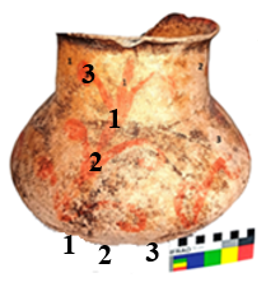
(d)

(e)
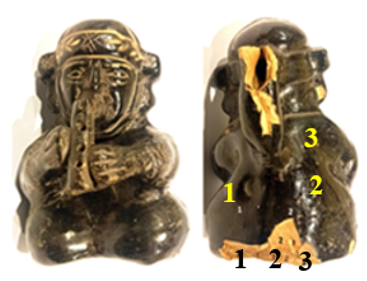
Results and discussion
Figure 2 shows the spectrum of the region of the ceramic paste from Guarani ceramic (object 2), while Figures 3 to 7 show the superposed spectrum of the pure ceramic paste and the regions with traces of red and black paintings on some of the objects analysed.
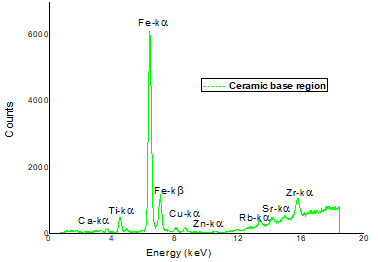
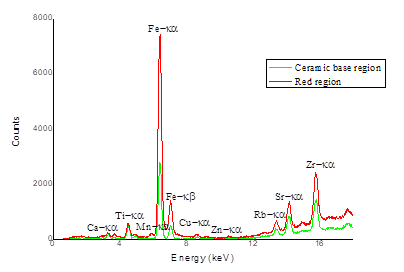



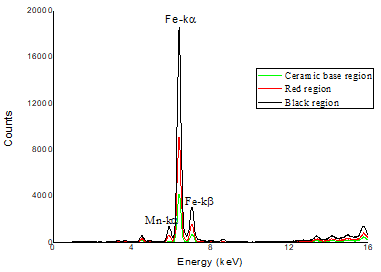
Table 1 shows, respectively, the values of the average net areas of the three points measured in the black region of a Chimu ceramic vessel (object 5).
| Element | Line | Net area | \(\sigma\) |
|---|---|---|---|
| Si | Ka | 372 | 36 |
| K | Ka | 2834 | 63 |
| Ca | Ka | 1119 | 52 |
| Ti | Ka | 1522 | 51 |
| Mn | Ka | 1428 | 49 |
| Fe | Ka | 119245 | 334 |
| Co | Ka | 5320 | 109 |
| Zn | Ka | 2199 | 56 |
| Rb | Ka | 8817 | 117 |
| Sr | Ka | 6512 | 109 |
| Y | Ka | 1750 | 109 |
| Zr | Ka | 5978 | 137 |
Analysing the measured objects, the presence, in variable quantities, of the elements Si, K, Ca, Ti, Mn, Fe, Cu, Co, Zn, Rb, Sr, Y and Zr were observed. The elements Si, K, Ca, Ti, Mn, Fe, Co, Zn, Rb, Sr, Y, and Zr were present in the ceramic paste of all the measured objects, indicating that they were present in the composition of the argil used in the fabrication of the respective objects.
In Oliveira et al., 2020, using the EDXRF technique, the concentrations of the elements Si, Fe, Ti, K, Ca, Zn, Sr, Mn, Pb, Rb, Zr, Cu, Cr and Al were obtained in the measured samples. Comparing the results, it is verified that most of the measured elements are repeated, independent of samples from different periods, geographical localization, and provenience, but with different amounts. In addition to the elements listed above, the presence of Cu was also observed in the ceramic paste of the Guarani ceramic vessel (object 2). After analysing the measured pieces using the AXIL software, the net areas of each element measured where there were traces of paint were compared with the areas measured in the ceramic paste of the respective piece.
For the spectrum presented in Figure 2 (referent to object 2), it was observed that there was an increase in the intensity of the lines referring to the Sr and Fe elements in the region with traces of paint. This indicates that there was a treatment in this region, using paint with raw material enriched with these elements, in the engobe. It can be observed that the X-ray lines of the Fe element presented a significant increase in intensity in the regions with traces of red paint and black paint when compared with the ceramic paste. The Mn element also showed similar behavior in the region with traces of black paint (see in special the Figure 7).
This indicates the use of paint containing oxides of these elements. The same behavior occurs with the Fe element in the region with traces of red paint on objects 1 and 3, suggesting the use of paint, containing a pigment based on this element (hematite) in its composition.
It is known that the red paints in Brazilian archaeological indigenous ceramics are due to hematite, either with the use of red ochre earth or laterites or red clays, which are rich in this material. The unequivocal presence and large amount of the element Fe in the red paints compared to the paste, attests that it is the key element of the red pigment, which within the above context could only be hematite, as measured by molecular methodologies (Appoloni et al., 2015; Oliveira et al., 2020).
In addition to the spectra presented, Table 1 shows an example of the behavior of the measured net areas of all elements after deconvolution with AXIL, with which net areas of all measured elements are determined, keeping only those with net areas greater than three deviations, to have good statistical robustness. The same elements were detected, with varying intensities, in all the ceramic pastes analysed. To discriminate between the pastes a simple comparison of the spectra is not effective. The better way is to perform a multivariate analysis of this data.
This analysis, the next step of this work, will be the Principal Component Analysis (PCA) and Hierarchical Cluster Analysis (HCA), of the elemental composition of the pieces. We could differentiate and correlate the groups of samples, because multivariate analysis allows the verification of the similarity between the sets of chemical elements identified in the objects of the same and different levels of stratigraphic profiles, permitting the grouping of ceramic objects made with the same type of clay (Ikeoka et al., 2018). With the use of such data analysis techniques, it would be possible to study even more profoundly the common or uncommon origin of the objects, which would contribute to improving the museum’s database, especially for those objects that do not have much information about their origin.
Conclusions
A total of 37 objects from the collection of the Museu Paranaense were studied, of which 19 were archeological ceramic fragments.
It employed the EDXRF technique, with a portable system (pXRF). Fourteen elements (Si, K, Ca, Ti, Mn, Fe, Cu, Co, Zn, Rb, Sr, Y and Zr) were measured in the selected ceramic pieces, five of which are discussed in detail in this paper. In these cases, the data analysis determined the key elements of the pigments present in the decoration, especially the paint and the slip, Fe and Mn, respectively for the red and black paint, indicating the use of raw materials rich in oxides of these elements in several different periods of time.
The portable XRF system proved to be robust and adequate for the in situ measurements. These data obtained contribute to the selection of more appropriate strategies for preventive conservation in the Paranaense Museum, especially with the collections of the Archaeology department.
Author contributions
M.S. Blonski participated in the: Conceptualization, Data Curation, Formal Analysis, Investigation, Methodology, Resources, Validation, Visualization, Writing - Original Draft Preparation, Writing - Revision and Editing. C.R. Appoloni participated in the: Conceptualization, Data Curation, Formal Analysis, Funding Acquisition, Investigation, Methodology, Project Management, Resources, Supervision, Validation, Writing - Revision and Editing. C.I. Parellada participated in the: Conceptualization, Data Curation, Formal Analysis, Investigation, Methodology, Project Management, Resources, Supervision, Validation, Writing - Revision and Editing.
Conflicts of interest
The authors declare no conflict of interest.
Acknowledgments
The authors would like to acknowledge MUPA (Museu Paranaense) for allowing access to and measurements of the objects in the collection and LFNA/UEL (Laboratório de Física Nuclear Aplicada da Universidade Estadual de Londrina) for allowing the use of the portable EDXRF system for the measurements. Authors also want to thank CNPq (Conselho Nacional de Desenvolvimento Científico e Tecnológico) for the financial support for this work.
References
Appoloni, C. R., Ikeoka, R. A., Marcori, O. H., & Arkley, M. (2015). Análise de cerâmicas de três sítios arqueológicos do Maranhão por EDXRF, Raman e estatística multivariada. In Simposio Latinoamericano de Física y Química em Arqueología, Arte y Conservación de Patrimonio Cultural [Simposio]. 5th Simposio Latinoamericano de Física y Química em Arqueología, Arte y Conservación de Patrimonio Cultural, Quito, Ecuador.
Estevam, M. (2005). Use of software in spectral analysis. (Technical Publication of the Laboratory of Applied Nuclear Physics, Dept. of Physics UEL pt 02 / 05). Universidade Estadual de Londrina.
Gianoncelli, A., & Kourousias, G. (2007). Limitations of portable XRF implementations in evaluating depth information: an archaeometric perspective. Applied Physics A, 89, 857–863. https://doi.org/10.1007/s00339-007-4221-4
International Atomic Energy Agency. (2005). In situ applications of X-ray fluorescence techniques: Final Report of Coordinated Research Project 2000-2003. International Atomic Energy Agency. https://doi.org/10.1016/j.nimb.2004.11.015
Ikeoka, R. A., Appoloni, C. R., Rizzutto, M. A., & Bandeira, A. M. (2018). Computed radiography, PIXE and XRF analysis of pre-colonial pottery from Maranhão, Brazil. Microchemical Journal, 138, 384–389. https://doi.org/10.1016/j.microc.2017.12.020
Oliveira, L. S. S., Abreu, C. M., Ferreira, F. C. L., Lopes, R. C. A., Almeida, F. O., Tamanaha, E. K., Belletti, J. S., Machado, R., Rizzutto, M. A., & Souza, D. N. (2020). Archeometric study of pottery shards from Conjunto Vilas and São João, Amazon. Radiation Physics and Chemistry, 167, 1–10. https://doi.org/10.1016/j.radphyschem.2019.04.053
Parellada, C. I. (2018). A cerâmica Guarani do Paraná, sul do Brasil: entrelaçando memória, tecnologia e arte. In Congresso Nacional de Técnicas Para as Artes do Fogo, [Anais]. 15th Congresso Nacional de Técnicas para as Artes do Fogo, Curitiba, Paraná.
Parreira, P. S., Melquíades, F. L., Lopes, F., Oliveira, V. F., & Appoloni, C. R. (2019). Sistema portátil de fluorescência de raios X (BR Patent 0801331-4) [Patent].
Scheuer, H. L. (1969). Estudo de um núcleo de cerâmica popular, baía das Laranjeiras, Paraná. (Nova Série Etnologia, Vol. 1). Arquivos do Museu Paranaense.
Szokefalvi-Nagy, Z., Demeter, I., Kocsonya, A., & Kovács, I. (2004). Non-destructive XRF analysis of paintings. Instruments and Methods in Physics Research B, 226, 53–59. https://doi.org/10.1016/j.nimb.2004.03.074
Vanvalkenburgh, P., Kelloway, S. J., Privat, K. I., Sillar, B., & Quilter, J. (2017). Rethinking cultural hybridity and technology transfer: SEM microstructural analysis of lead glazed ceramics from early colonial Peru. Journal of Archaeological Science, 82, 17–30. https://doi.org/10.1016/j.jas.2017.04.003
Van Espen, P., Nullens, H., & Adams, F. (1977). A computer analysis of X-ray fluorescence spectra. Nuclear Instruments and Methods, 142, 243–250. https://doi.org/10.1016/0029-554X(77)90834-5
Estevam, M. (2005). Use of software in spectral analysis.
Galvão, T. D., Appoloni, C., Poupeau, G., Lopes, F., & Scorzelli, R. (2020). Non destructive sourcing of obsidians by two different home made pxrf devices: Analytical capabilities for provenance studies. Journal of Anthropology and Archaeology, 8, 1–14.
Parellada, C. (2014). Coleções arqueológicas no museu paranaense: Trajetórias e memórias. Memorare, 2(1), 72–92. https://doi.org/10.19177/memorare.v2e1201472-92
Pouyet, E., Barbi, N., Chopp, H., Healy, O., Katsaggelos, A., Moak, S., Mott, R., Vermeulen, M., & Walton, M. (2020). Development of a highly mobile and versatile large ma-xrf scanner for in situ analyses of painted work of arts. X Ray Spectrom. https://doi.org/10.1002/xrs.3173
Molari, R., & Appoloni, C. (2021). Pigment analysis in four paintings by vincent van gogh by portable xray fluorescence (pxrf). Radiat. Phys. Chem., 181, 109336. https://doi.org/10.1016/j.radphyschem.2020.109336
Noelli, F., & Sallum, M. (2020). Comunidades de mulheres ceramistas e a longa trajetória de itinerância da cerâmica paulista. Revista do Museu de Arqueologia e Etnologia, 34, 132–153. https://doi.org/10.11606/issn.2448-1750.revmae.2020.166053
Wauters, V. (2016). Imperial needs, imperial methods: Chimú ceramic manufacturing process through ct scan analysis of stirrup-spout bottles. Latin American Antiquity, 27(2), 238–256. https://doi.org/10.7183/1045-6635.27.2.238
